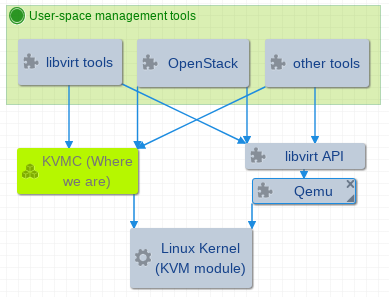User-space toolkit to manipulate and control KVM guests.
Virtualization is all about isolation and efficiency, and we try to eliminate QEMU blocks in the following diagram.
The objective is an efficient, developer friendly, production ready dynamic library, with bindings to different languages(for platform integration). It should make use of VT-d enhanced device emulations, and probably a few legacy ones in the meantime.
-
KVM offers CPU virtualization only, and is not a full system virtualization solution, that's where QEMU finds its place. We are moving on to device virtualizaton for better performance, dependency on QEMU seems to be weaker.
- Many of device virtualization tricks burst in to horizon, like IOMMU, SR-IOV, sPAPR, PCI-passthrough, VFIO, ...
- A relatively simpler context allows device virtualization developers quickly apply their implementations
-
Existing implementations, like QEMU/KVM, novm, kvmtool, have their limitations
- As mainstream solution, QEMU endures relatively large codebase, most of which is unnecessary, under virtualization environment(CPU part is replaced by KVM, and device part is been replaced by evolving VT-d ones)
- QEMU-lite is a working-on project that's smaller than full-functional QEMU at runtime, but won't reduce much of programmers' burden in the near future
- KVMTOOL targets on been KVM functionality testing utility, and is not for production, moreover, it seems to have been abandoned
- NOVM targets on restricted hardware and use case(Google Cloud Platform), and most of all, it seems to be turned private
- Nitro aims on constructing baremetal, lightweihted Virtualization platform, that supports KVM, Xen, containers, accesses all PMCs, similiar to NOVM, it's not available for public use.
-
Security is a not-so-important, and so important topic, larger codebase is likely to introduce more bugs
The goal of this tool is to provide a clean, from-scratch, lightweight KVM host tool implementation that can boot Linux guest images (just a hobby, won't be big and professional like QEMU) with no BIOS dependencies and with only the minimal amount of legacy device emulation.
It's great as a learning tool if you want to get your feet wet in virtualization land: it's only 5 KLOC of clean C code that can already boot a guest Linux image.
Right now it can boot a Linux image and provide you output via a serial console, over the host terminal, i.e. you can use it to boot a guest Linux image in a terminal or over ssh and log into the guest without much guest or host side setup work needed.
Non-QEMU implementation: Google does not use QEMU, the user-space virtual machine monitor and hardware emulation. Instead, we wrote our own user-space virtual machine monitor that has the following security advantages over QEMU:
Simple host and guest architecture support matrix. QEMU supports a large matrix of host and guest architectures, along with different modes and devices that significantly increase complexity. Because we support a single architecture and a relatively small number of devices, our emulator is much simpler. We don't currently support cross-architecture host/guest combinations, which helps avoid additional complexity and potential exploits. Google's virtual machine monitor is composed of individual components with a strong emphasis on simplicity and testability. Unit testing leads to fewer bugs in complex system. QEMU code lacks unit tests and has many interdependencies that would make unit testing extremely difficult.
No history of security problems. QEMU has a long track record of security bugs, such as VENOM, and it's unclear what vulnerabilities may still be lurking in the code.
